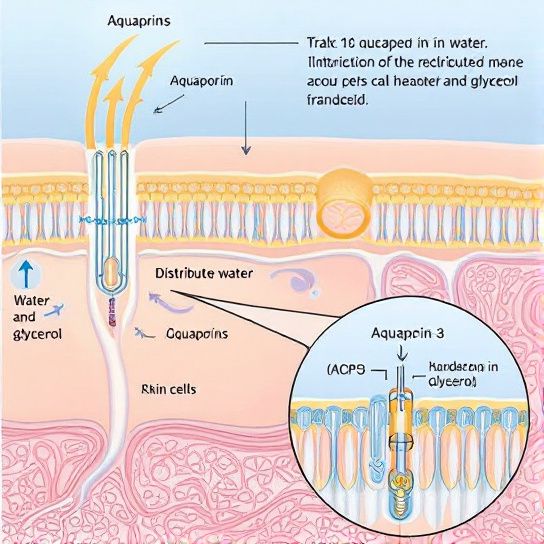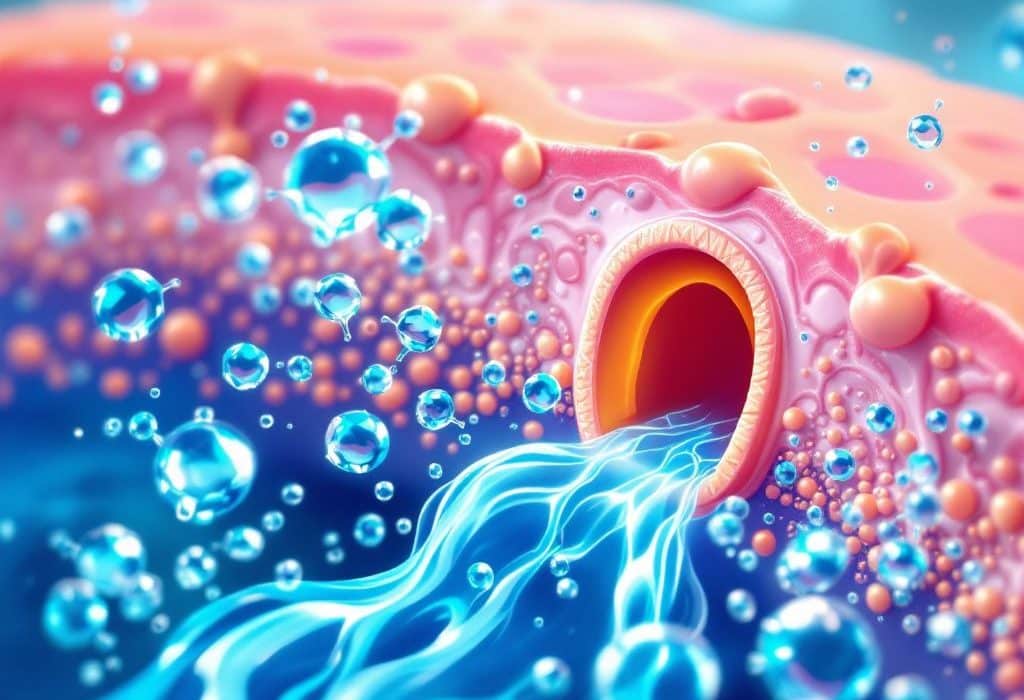Hey there! Have you ever wondered how your skin stays hydrated and glowing—or why, sometimes, it feels like a desert despite all the fancy lotions and potions? Let’s dive into something that might just surprise you: aquaporins. These microscopic proteins hold the mystery key to understanding our skin’s hydration. Intriguing, right? To truly grasp the profound impact of these proteins on your skin’s health, it’s beneficial to explore the science behind skin hydration, which reveals their crucial role in maintaining moisture balance.
Understanding Aquaporins: Water’s Gatekeepers
Let’s start simple. Aquaporins—sounds pretty scientific, but they’re actually straightforward. Picture them as tiny doorways sitting in the cell walls of our skin. They allow water to flow in and out of the cells. Yep, water channels, literally. Without them, our skin’s hydration game would be, well, pretty weak. Understanding the key players in cellular hydration can provide deeper insights into how these proteins function as fundamental components of your skin’s moisture retention system.
Imagine for a moment if these gateways were stalled or dysfunctional. Your skin could struggle to cling onto moisture, no matter how much fancy moisturizer you slather on. It’s not just about drinking more water but maximizing its cellular journey where skin aquaporins play the quintessential part. For those interested in hydration science, understanding these mechanics could reveal why some moisturizers outperform others in retaining skin moisture.
The Dance of Skin Cells and Water
Aquaporins weren’t always in the spotlight. It wasn’t until the late ’80s that scientists even got wind of their existence. Crazy, huh? Dr. Peter Agre, the guy who snagged the Nobel Prize in Chemistry back in 2003, introduced us to aquaporins. These proteins aren’t just in our skin—they’re everywhere, from kidneys to our eyeballs. But here, we’re zeroing in on how they jam with skin cells. Exploring the relationship between cellular hydration and aging can illuminate the significance of aquaporins in maintaining youthful, resilient skin.
Unearthing the Function of Aquaporins
Let’s cut to the chase. Aquaporins slam open pathways for water inside the skin cells and literally boost its distribution across them. There are different types of aquaporins: water only or the mixed kind for water plus all those deliciously small solutes like glycerol. Think of it like this: fifth gear hydration! If you’re fascinated by how hydration enhances skin health, you might consider delving into anti-aging solutions that specifically target dehydrated skin to optimize aquaporin activity.

Studies show an incredible interplay between aquaporins and skin health. Aquaporin-3 (AQP3), our star player, handles not only water but glycerol too, ensuring the skin stays supple. Like AQP3’s trusty sidekick, Glycerol enriches the skin structure from within, enhancing elasticity and resilience. This synergy is akin to the effect of hyaluronic acid, which also plays a vital role in maintaining skin’s hydration and plumpness.
Here’s why aquaporins are significant. They don’t just pipe in moisture—nope, they manage other substantive tasks too. They aid cell proliferation, transport nutrients, and sweep out nasties we don’t need. Balanced aquaporin activity results in optimally hydrated, even-toned, and healthy skin, similar to the results achieved through natural anti-aging supplements which support overall skin vitality.
The Science of Hydration: More than Just Moisturizers
You might be asking, ‘So, can boosting aquaporins in my skin make me look a zillion times more hydrated?’ In a nutshell—yes. Let’s break down into how this plays a role in the cosmetics and skincare industry. By incorporating ingredients that enhance aquaporin activity, skincare products can significantly improve hydration levels, much like the principles of hydration layering which aim to maximize moisture retention through strategic product application.
Enhancing Aquaporins in Skincare
Research has savvy cosmetic formulators absolutely buzzing to include aquaporin-targeting ingredients. Moisturizers and serums that stimulate AQP3 increase skin moisture levels from the deep, dermal layers up to the topmost squamous. By focusing on such targeted hydration strategies, you can address the challenges posed by humidity and aging, ensuring your skincare regimen is well-suited to your environment.
Top Triggers for Aquaporin Production:
- Glycerol: Famed for its moisturizing ability, glycerol naturally revs up aquaporins.
- Natural Extracts: Things like aloe vera, known for soothing skin irritation, also whisper sweet nothings to aquaporins to get them working overtime.
- Vitamins B3 and B5 (Niacinamide and Panthenol): Ace in tackling skin’s brilliance and texture while switching aquaporins into action mode.
Choosing products rich in these components can lead to visible improvements in your skin’s hydration. Integrating such elements into your routine can help manage cell hydration, keeping your skin’s moisture levels balanced and healthy.
Integrating Aquaporin-friendly Routines

Trust me on this, trying a routine enriched with aquaporin-boosting geekery is an adventure your skin craves. Go for products listing key additives that are proven aquaporin allies. Here’s a wee routine suggestion:
- Cleanser: Gentle, non-stripping, maintains natural oils.
- Serum: Look for niacinamide and glycerol-rich options.
- Moisturizer: Keep it creamy, not greasy—with aquaporin hero ingredients.
Switch it up, listen to your skin’s needs, and source from what works best through trial. This practice aligns with the broader anti-aging strategy that emphasizes personalized care for optimal results.
Common Misconceptions about Skin Hydration
One snag is forgetting aquaporins are part of the broader fabric of skin activity. Hydration depots within skin are always shifting gears to morph with climate, diet, and even mood fluctuations. Some myths to squash?
Avoiding Overcomplications
- More moisturizer equals more hydration? Not quite. Without the aquaporins tailored approach to hydration regulation, moisture will struggle to penetrate effectively.
- All skincare boosts aquaporins. Use verified ingredients. Look at these labels under a lens, because not all products knocking on aquaporins’ door have the right key.
- Aquaporins need constant stimulation. Incorrect! They maintain a natural rhythm supported by good diet and moderate daily hydration.
Delving Deeper: Cellular Water Travel

Picture a grand highway. Cars whizzing through likening to water molecules transiting through aquaporins. Just like highways, these routes can face jams—injuries or stress affecting cellular efficiency. To maintain smooth cellular operations, consider incorporating skincare tips that enhance aquaporin function as part of your daily routine.
Aqua-Science Hack: Future Prospects
Like any science, research continues. The latest in cell biology has AQP3 expansion not stopping near skin roadways—but racing further to chronic skin disorder realms. Bringing potent paths towards eczema management—exciting, no? This exploration into aquaporins could redefine how we view skincare, much like the evolving understanding of natural supplements in anti-aging treatments.
Novel Discoveries in Aquaporin Research
Emerging innovations endeavor create therapies where manipulating aquaporins could effectively address dry skin conditions. Enhanced aquaporin function lends hand in balancing moisture and rebuilding dermal defenses—less scaling, more radiance. The future seems aquaporinful! For those intrigued by cellular hydration advancements, exploring the impact of climate on aging skin can illuminate these new frontiers.
The Bottom Line: Taking a Fresh Hydra-Reframe
Alright, let’s wrap it up. Ponder on aquaporins from your daily sink-to-face mirror ponder. See these water ticket takers not unlike exceptionally adaptable DJs spinning noodles in the cellular nightlife, keeping skin vivacious. Seriously, aquaporins aren’t just skin fillers. When combined with a well-rounded approach to hydration and anti-aging, such as using solutions for dehydrated skin, they can significantly enhance your skincare results.
Hydrate smartly! Start syncing inward with cellular waters as truly only aquaporins ensure the most efficiency.
There you have it. Next time you’re selecting that lotion or serum, let aquaporins navigate innovative skincare routines to collectible experience enhancing reflections—a friendly reminder of how these microscopic proteins orchestrate your (well-hydrated) future. Embracing natural supplements alongside these routines could further optimize your skin’s health and vitality.
Frequently Asked Questions
What are aquaporins and what is their function?
Aquaporins, also known as water channels, are channel proteins that form pores in the cell membrane, facilitating the rapid transport of water and, in some cases, other small uncharged molecules like glycerol, ammonia, and CO2 across the cell membrane. They are crucial for various biological functions, including osmoregulation, secretion, and filtration of fluids[1][4][5).
What is the structure of aquaporin proteins?
Aquaporin proteins are composed of six transmembrane α-helical domains with both amino and carboxyl terminals facing the cytoplasm. They assemble in the cell membrane as tetramers, with each monomer containing a distinct water pore. The structure includes hydrophobic loops with a conserved asparagine–proline–alanine (NPA motif) and a narrow pore that allows water molecules to pass through in single file[1][2][4).
How do aquaporins regulate water transport in cells?
Aquaporins regulate water transport by creating a selective pathway for water molecules to move across the cell membrane, while preventing the passage of ions and other charged solutes. This is essential for maintaining the cell’s electrochemical potential and for efficient osmoregulation. Water moves through aquaporins based on the osmotic gradient, allowing cells to rapidly adjust to changes in their environment[1][4][5).
What are some of the diseases associated with genetic defects in aquaporin genes?
Genetic defects involving aquaporin genes have been associated with several human diseases, including nephrogenic diabetes insipidus, which affects the kidney’s ability to reabsorb water, and neuromyelitis optica, an autoimmune disease affecting the central nervous system. Other conditions, such as congenital cataracts, are also linked to impaired aquaporin function[1][5).
References- Wikipedia. Aquaporin.
- King, L. S., et al. Structure and function of aquaporin water channels. American Journal of Physiology-Renal Physiology, 2000.
- Study.com. Aquaporins | Definition, Structure & Function.
- University of Illinois. Structure, Dynamics, and Function of Aquaporins.


